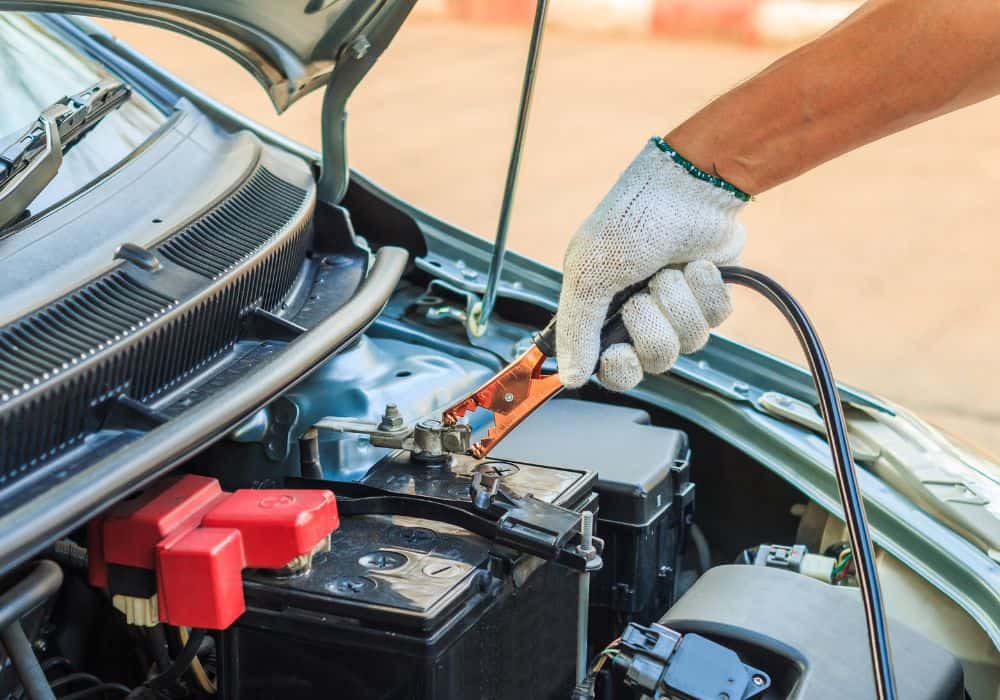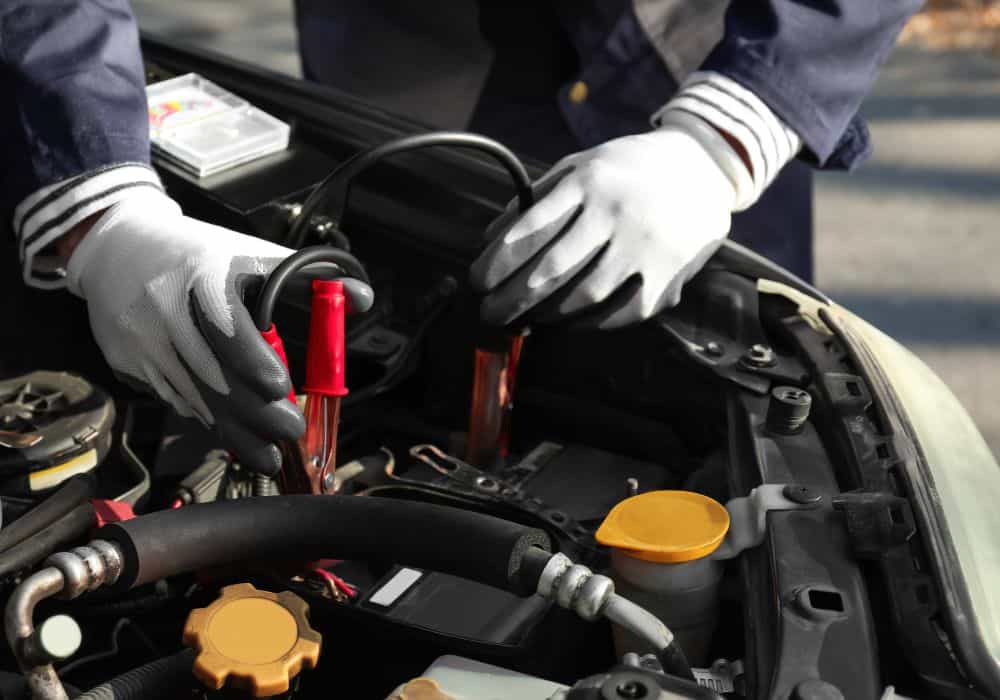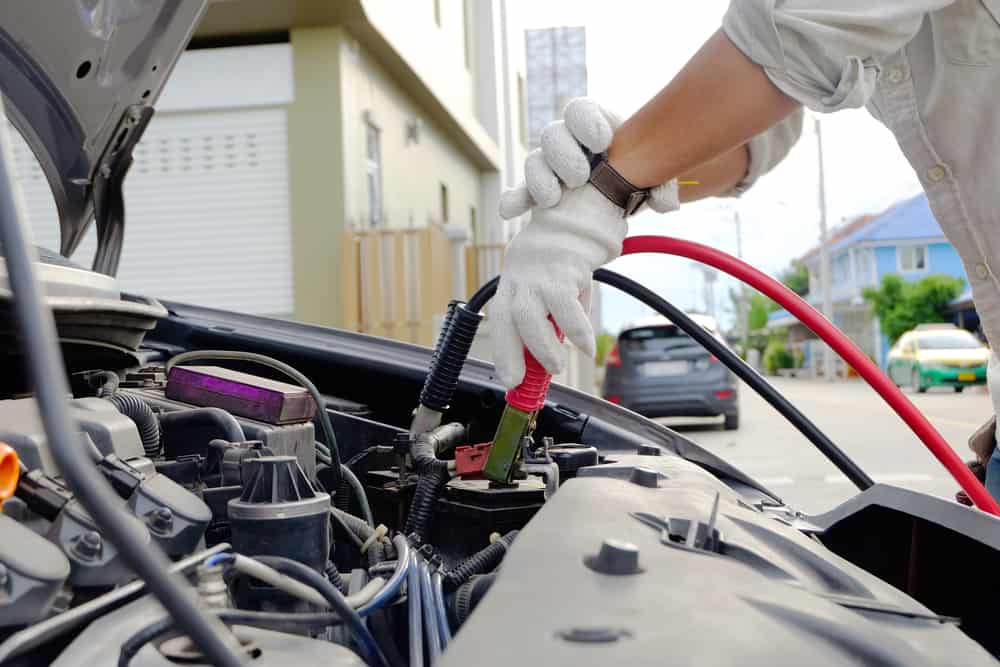Waking up to a completely dead car battery can change the trajectory of your day and put you in the worst mood possible. While it may seem like a dead end, there are several ways you can wake that battery up and get behind the wheel again.
To power your car if the battery is completely dead, you need to first determine what could be the cause. You can jumpstart the battery using another car’s battery and jumper cables. Alternatively, you could use a portable jump starter to start the car; this is assuming your car’s battery is only flat.
However, if your car has been sitting in the garage for too long, it is possible that sulfation has set in. If the sulfation is still reversible you can wake up your battery by feeding the battery with an overcharge current.
In this article, we’ll provide ways to spot signs that may mean the end is here for your battery, how to jump-start it, and ways to maintain it, so it doesn’t flake on you again.
Table of Contents
How To Jump Start A Dead Battery Using Jumper Cables?

You can jump-start your car battery through these 7 quick steps. It’s a very easy process in the comfort of your home.
Step 1: Get A Working Vehicle
First, you’ll need another car with a fully charged battery to jump your battery and the cables to connect them. We advise you to keep this cable handy, as a dead car battery is a common issue.
Step 2: Bring The Engines Close
When the car and cable are set, bring the engines of both vehicles close for proximity and to make it easier for the cable to connect. You can either park them parallel or face each other but not farther than two feet away.
Step 3: Turn Off Vehicle And Connect the Positives
Turn both vehicles off. Connect the positive (red) clamps of the cable to the positive terminal of your battery. They’re usually marked but hide in plain sight. So, check closely to confirm that you’re connected to the appropriate position.
Step 4: Connect The Negatives
Next, connect the negative (black) clamps of the cable to the negative terminal of the active battery, and inside your car, insert the negative terminal into an unpolished metal part.
Note: When jump-starting your battery, put safety first. Before connecting the positive cable to the battery, ensure you connect the flat battery first. If you pump energy into the wires before they’re connected to your battery, it may cause shock or a more severe safety hazard.
Step 5: Start Working Vehicle
Start the working vehicle and leave it to run for a few minutes while it charges up your dead battery to have enough power.
Step 6: Start Your Car And Disconnect the Cables

Try to start your car while it’s still connected to the working vehicle, and if it doesn’t respond, wait for a few minutes, and try again.
Disconnect the cable in reverse order from their placement in the vehicles. First, the black cable from your car, then the same for the other vehicle, then the red cable from your car, and lastly, remove the positive cable from the working car.
Step 7: Drive Your Car Around
Your battery gets charged while you drive, so after the jumpstart process, take a farther route to your house to give it a proper charge.
If your car doesn’t come on after you jump start it, take it to a mechanic, as it may be an issue with the alternator and starter.
How To Reverse Sulfation
There are two types of sulfation; permanent and reversible. While the former is caused by your battery being at a low voltage for months and may not be restored, the latter can be corrected by doing a simple trick which we’ll talk about below.
You can reverse sulfation by overcharging a fully charged battery with a regulated current of about 200mA for about 24 hours. The current makes the battery terminal voltage increase between 2.50 and 2.66 volts per cell which dissolves sulfate crystals.
Remember that sulfation is hard to reverse in AGM and thin plate pure lead AGM batteries as they don’t react well to low-voltage charging.
Five Common Signs of a Dead Battery in a Car
If your car displays one or more of these signs, you have a flat battery. Check out the reasons.
1. Unresponsive Car
The next thing to do after getting in a car is to insert the keys and start the ignition; while you’re supposed to get a kick, a dead car battery will only make your vehicle give a ticking or whining sound, and it’ll be fully unresponsive.
The first thing you must do after only two attempts at starting your car is to refrain from going further, as this will aggravate the state of the battery. Instead, get a vehicle to help jump-start your battery. A jump start can help you cover a reasonable distance, make a trip to the battery shop for a new battery, or go to a mechanic.
However, jump starts are temporary fixes as the problem is most likely to come back, so make sure to seek more permanent solutions if this ever happens to you. If you encounter a completely dead battery problem again, it’s a sign that you need to get a new one.
2. Inactivity

A dead battery isn’t far-fetched if you barely use your car except for a special outing. We advise that you don’t let your vehicle sit idle for months without use as this will drain the voltage of the battery and won’t come on when you need it.
Jump-starting the car battery, yourself may not be the perfect solution; although it may work, you may still need professional help to get it to function properly. Factors like corrosion, bad weather, rust, and alternator trouble may be one of the reasons why your car battery is discharged or completely dead.
3. Check the Engine Light
Most car owners will agree that they ignore the very important check engine light that usually flashes on the dashboard, and this is not a healthy practice as it may damage the car and even affect you if it malfunctions.
Checking your battery may be the solution to stop the flashing, check the engine light, and even fix other things wrong with your car. You can change the battery yourself, boost it or go to the store to get a new battery.
4. Foul Smell
There’s a particular smell associated with damaged batteries; it usually smells like rotten eggs due to the smelling sulfuric acid from the car battery that’s currently leaking. A leaky car battery is not safe for your car and battery.
A leaky battery should go for repairs as swiftly as possible, and replacing the battery is usually the last resort. Ensure to wear gloves and protective gear if you’re handling it yourself.
5. Electrical Component Issues
Your car may start, and work fine but still have a low battery. How? You may discover electrical parts in your vehicle, like radio and headlights, and your air conditioning system may suddenly stop functioning.
While you may fix this issue by going to the mechanic, they can reoccur again, except if you purchase a new battery that will sustain you for a longer time and save expenses.
5 Factors That Lead To A Dead Battery
Car batteries consist of an electrolyte and two or more electrodes. The electrolyte helps store chemical energy and convert it to electrical power on command from the engine. As time goes by, the electrolyte will get weaker and corrode.
The average lifespan for a car battery is about 3-5 years, but they can pass out before their stipulated time due to numerous factors. Check them out below.
1. Corrosion
Leakage of battery electrolytes can cause corrosion of battery terminals, and you’ll see it in green, blue, or white residue at the positive and negative terminals of the battery’s connection. This can cause electrical resistance in the terminal and stop your battery from getting a proper charge.
2. Loose Connections
Loose terminals can stop properly charging your car’s battery leading to a start failure. You must embark on a routine check-up for your car battery to ensure they’re secure and in place and tighten any loose parts.
3. Bad Alternator
An alternator is a very important part of your car that helps charge your battery and powers your car’s electrical system during its working. If your alternator has a faulty diode, it’ll cause your battery to keep recharging itself even when your car engine is turned off, and your battery will die due to charging errors.
4. Indirect Drain
The continued discharge of power through different electric parts of your vehicle, which stays on even when your engine is inactive, is known as a parasitic drain and can sniff the life out of your battery completely. This drain may be caused by faulty fixes, incorrect wiring, or bad fuses.
5. Extreme Weather Conditions
Cold weather can kill your battery; at 0 degrees, your car’s strength reduces by 60%, which explains why most car owners cannot start their vehicles on cold winter mornings. The same goes for raging heat that can cause the electrolyte to evaporate and reduce the active area of electrode pads, causing Sulfation.
Final Words
It’s possible to recharge your dead battery, and now you can do it yourself should you be stuck on a lonely road at night or in an area with poor reception with the help of our qualitative guide.
However, if you’ve tried charging it by driving around, and jump-starting, and it still doesn’t work, you may need to replace it with a new battery. Whichever you decide, be careful not to waste time, as this can permanently damage the battery.
